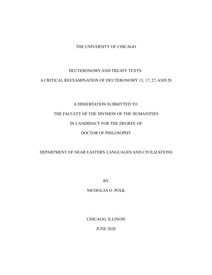This study critically reexamines claims that Deuteronomy 13, 17, 27, and 28 were influenced by ancient Near Eastern treaty texts or traditions. It has long been recognized that the literary structure of the book of Deuteronomy strongly resembles the organization of material in treaty documents. The latter often contain such elements as a preamble and historical prologue (cf. Deut 1-11), stipulations in second-person (cf. Deut 12-26), and blessings and curses (cf. Deut 27-28) in a sequence corresponding to that in the biblical book. In recent decades, a strong case has been made as well for the direct dependence of several passages in Deuteronomy on “Esarhaddon's Succession Treaty” (EST), also known as the “Vassal Treaties of Esarhaddon” (VTE), although this proposal remains a controversial one. The discovery of a new exemplar of EST at Tell Tayinat, this study demonstrates, strengthens arguments for a literary relationship between this text and Deuteronomy. It affords tantalizing evidence that copies of EST were deposited elsewhere in the Levant, while its use as a display piece near a possible altar calls to mind the Mosaic command in Deut 27:1-8. In addition, this study presents new literary evidence that a copy of EST probably influenced the composition of Deut 13:1-12 and 28:20-44. Close examination of the chiastic structure of Deut 28:20-44* demonstrates the literary creativity of the Deuteronomic writers, bolstering claims that they may have borrowed from EST in a highly creative fashion. Most strikingly, the similarities between EST and Deuteronomy 28 terminate precisely at the midpoint (Deut 28:31-32) of the chiastic structure. This is unlikely to be coincidental, but more plausibly reflects the dependence of Deut 28:23-31 on passages in EST.
Degree Type Ph.D.Content Type DissertationAcademic AdvisorCommittee MemberSubjectsDigital Object Identifier 10.6082/uchicago.2269LicensingUniversity of Chicago dissertations are covered by copyright.Publication Date 2020-06Language enRecord Appears in Humanities Division > Near Eastern Languages and Civilizations
AllRecord Created 2020-06-29










 Stumble It!
Stumble It!

No comments:
Post a Comment